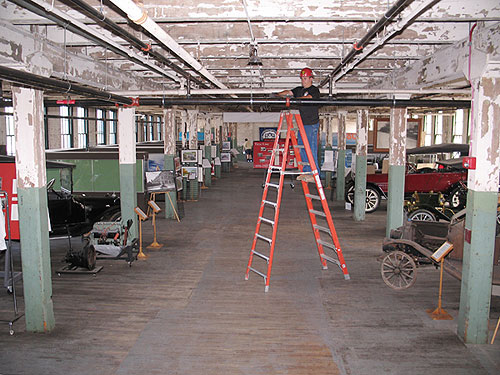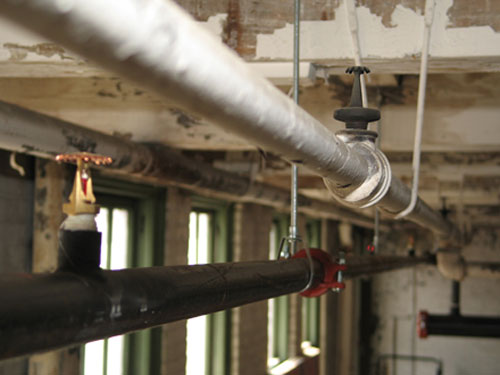Modern fire sprinklers now guard Ford’s historic Piquette Ave. plant
Date Posted: August 12 2011
The architects had the Piquette plant built with the latest fire-suppression systems, including fireproof doors that could isolate the plant into four sections, iron caps that acted as firestops atop the structure’s wooden beams, camphered beam edges which could slow the progression of a fire, and three-inch thick maple floors. And Ford and his architects took the building’s design a step further than most commercial and industrial buildings of the day, by opting to install a sprinkler system in the building.
That same sprinkler system is still in place and likely would still work today, at some capacity, although it wouldn’t meet modern building codes. That’s why today’s owners and guardians of the Piquette Plant, the Model T Automotive Heritage Complex (T-Plex), are so happy to see their long-held wish granted this summer: the installation of a modern sprinkler system.
“We’ve been scared to death of a fire at the Piquette Plant,” said the T-Plex’s first President, Richard Folsom. “We’re thrilled that we’re getting the new sprinkler system.” A June 2005 fire that wiped out a nearby historic Studebaker Plant from the same era “really ramped up our zeal to do this,” said Dick Rubens, the T-Plex’s current president.
Systematic Fire Protection and a small crew of Sprinkler Fitters Local 704 members have worked at the three-story plant this spring and summer, installing some 2,500 feet of four-and six-inch-diameter sprinkler pipe and 587 sprinkler heads. The project is expected to wrap up by the end of summer.
The initial scope of the project called for the removal of the old sprinkler system, whose pipes and heads are exposed overhead throughout the building. The original system was built by General Fire Extinguisher Co. for $5,100. But the T-Plex Board changed their mind and decided to leave the old system in place as an architectural artifact. That lead to some recalculations and new measurements for the Systematic crew, who now had to work around the existing system and drill their own holes through a few 18-inch-thick brick walls.
The plant is 402 feet long, but it’s only 56 feet wide. “We were severely limited on what we could do and where we could run the pipe,” said Systematic’s Rick Michaels, who designed the system. They bid $230,000 for the project. “Things moved a bit slowly because there are a lot of old cars on display here, and people here visiting the museum. But we stayed out of the way as much as possible and did the best we could. I’m really excited about this project. We’ve met a lot of interesting people, and it’s nice to be a part of this building’s history.”
And what a rich history the building has. It was the first factory built by Henry Ford, and his early Models B, C, F, K, N, R, S, and T were assembled at the plant before Ford Motor Co. outgrew the space and moved in 1910. Ford dabbled with aspects of the moving assembly line at the Piquette plant, later perfecting them at his Highland Park and Dearborn Rouge plants. “Ford literally changed the way things were manufactured in the world, and he started right here,” Rubens said.
The Piquette plant has city, state and federal historic landmark status. And the T-Plex is in the long process of seeking a status for the building as United Nations World Heritage Convention site. That list currently includes 936 properties around the world “forming part of the cultural and natural heritage which the World Heritage Committee considers as having outstanding universal value.”
The plant’s third floor manufacturing area is virtually unchanged since it was built, with the same oil-soaked flooring and the same paint on the walls. With the sprinkler system nearly complete, next on the T-Plex’s to-do list is to install a new roof and put in a new six-volt carbon arc lighting system similar to what was used when the building opened, a task which will be handled by IBEW Local 58 electricians working for Motor City Electric.
According to the T-Plex, Ford outgrew the building, located near Detroit’s News Center area, and sold it to the Studebaker Corp. in January 1911. The company built an attached Albert Kahn designed parts storage and service building in 1920. Subsequent owners were the 3M Corporation, Cadillac Overall Company and Heritage Investments. A widely read article in the 1990s by Trent Boggess called “Henry Ford’s Forgotten Factory” brought new attention to the building, and the T-Plex acquired the building in April 2000.
Today the Piquette Plant is a burgeoning museum, with numerous old cars and displays illustrating the rise of the Ford Motor Co. and the rest of the automotive industry in Detroit. Rubens said repairs and updates are happening slowly but surely at the old plant as money becomes available. We published a feature on repair work at the Piquette plant by BAC Local 1 masons on the job in 2008.
The sprinkler work “has gone better than I envisioned, and the disruption to our operation was minimal,” said Rubens, who added that Systematic used “a very sharp pencil” when it came time to bid the work – which is tremendously important to a museum that’s hardly flush with cash. “These guys did a great job.”
There’s not much difference between the old sprinkler system and the new one, Michaels said.
The pipes are wider today and less prone to corrosion, but the sprinkler heads then and now are designed to deluge an area with water when excessive heat is detected. “The system they installed has held up well over the years, “Michaels said. “It’s certainly the oldest system I’ve ever encountered, but the technology hasn’t changed much over the years.”
(For information on the Piquette museum, go to www.tplex.org or call 313.872.8759).

INSTALLING A COUPLING on a sprinkler cross main on the third floor of the old Ford Motor Co. Piquette Plant in Detroit is Jeff Gray of Sprinkler Fitters Local 704, working for Systematic Fire Protection. Henry Ford’s first concept of an automotive production line took place on this floor, and it is virtually unchanged from a century ago.

A NEW SPRINKLER HEAD, at left, is among 587 sprinkled throughout the Piquette Plant that will make the historic facility safer for its visitors and its contents, which includes a variety of antique cars. Original, century-old sprinkler pipe and heads, shown at right, have been kept in place.
